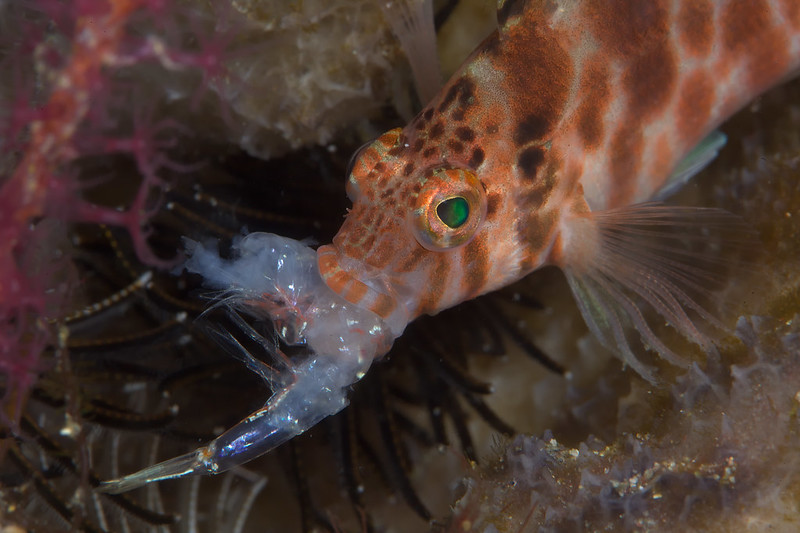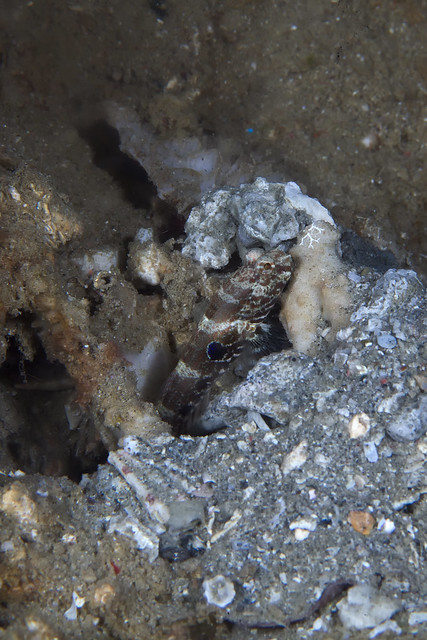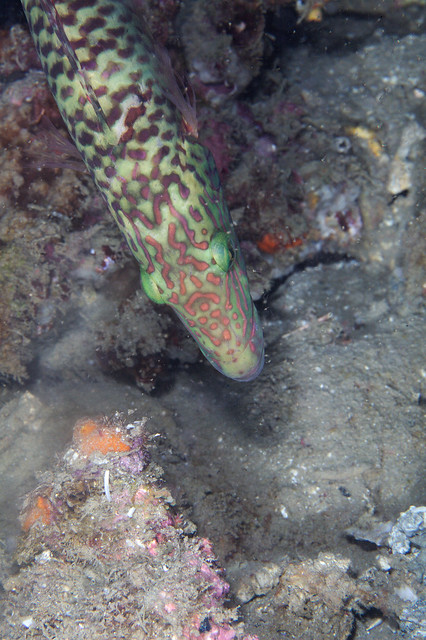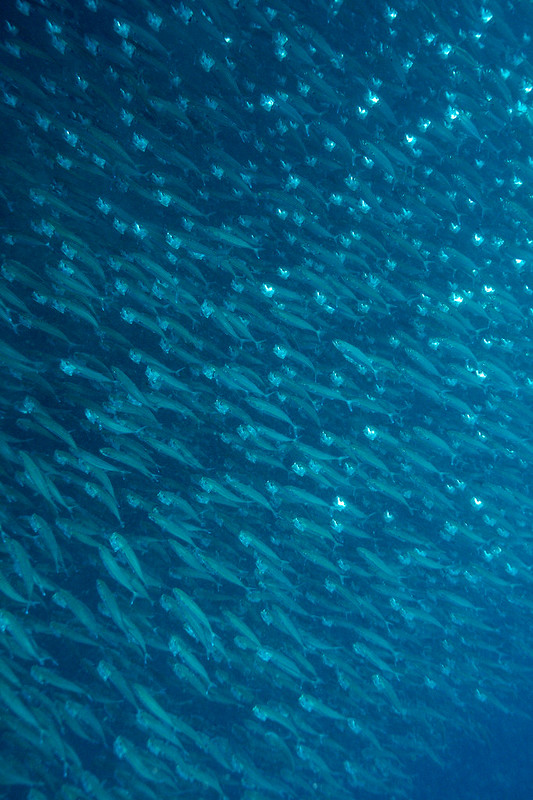Anilao is Awesome
Sometimes when I am in the middle of something I get a bit tunnel-visioned. I am having a good time, yes, but my perspective is sometimes a tad narrowed. “Am I gonna be able to have a nap before the next dive?” “Where are my sunglasses, damnit?” “Should I ask for a second helping of ice cream?” These are the questions which sometimes occupy my mind. Yes, during the actual dives I am very enthusiastic about the marine life in front of my mask, but before and after I sometimes get distracted by everyday trivialities more than I would like to. Only after the end of the experience do I then realize just how extraordinary and special it was what I just saw and experienced.
My month of diving in Anilao with the Aiyanar Beach & Dive Resort was one such amazing experience which only now sinks in with its full weight. There was some spectacular natural history going on underwater!
HAWKFISH LUNCH
I saw a hawkfish hunt a shrimp in a black coral. That particular black coral was full of these half-thumb-sized, frail translucent shrimp. Very hard to see at the reduced light levels at 30 meters, and probably even more so when you only have the much smaller eyes of a 10 cm long fish to look for them. Still, the hawkfish got a shrimp, but then it immediately had to defend it against a hungry wrasse of about the same size. It then darted over to a cup-sponge next door and started chewing the shrimp which was much more than bite-sized for that fish.

A gazelle captured by a cheetah which then has to defend it against a pack of hyenas in the African savannah? The hawkfish, shrimp & wrasse episode was at least as exciting and all involved animals were way more pretty than those hyenas which somewhat look like Filipino street dogs anyway.
MIDWATER MATING
I saw rare and incredibly beautiful flasher masses wrasses mating in mid-water over an incredibly beautiful sun-drenched coral-covered reef wall. The males were each defending a territory and did impressive mating dances with widely spread fins when we encountered them. Very hard to photograph.
GOBY DEMISE
Then I saw a shrimp goby – a rather rare one, of the species Cryptocentrus caeruleopunctatus – in his hole with his symbiotic shrimp. The shrimp digs a hole, and the goby acts as a watchman. If danger approaches, the goby retreats into the burrow, and the shrimp notices that and also stays inside. That on its own is not such a rare natural history event, it can easily be observed by an attentive diver in the sand next to most coral reefs in the Indopacific, especially in low-current areas. This is a relatively rare shrimp goby, though, and I really enjoyed finding one.

But what I saw then was quite stunning: A medium-sized wrasse had followed me around. When I took a picture of the shrimp-goby, it must have realized that I was looking at something. I surely think that the wrasse does not understand what a camera is and what taking a picture entails. But it probably has some understanding of looking at things. Any vertebrate has eyes on the front of the head, and pointing that head somewhere usually means looking at something there. Looking is such a universal act that the wrasse most likely realized that I was looking at something – something edible?
When I took the picture of the shrimp goby, I spooked it and it retreated into its burrow. It usually takes a minute or two for the goby to come back out. The wrasse was willing to wait. Did it know that a circular hole in the coral rubble likely is a goby burrow? Wrasses and gobies have been living in the same reef ecosystems for millions of years, so that’s certainly possible. Hence, the wrasse patiently looked down onto the burrow, hovering and hovering … until the goby came out, then it quickly struck, and enjoyed its snack. A few seconds later, in mid-water, pieces of coral rubble were dripping from the successful hunters mouth.

If you think that fishes are stupid, then you are stupid or you have never been underwater!
CONVICTS
On the dive site “Sombrero” I saw juvenile convict fish streaming in and out of the burrow which an adult convict fish had dug. The adult, much much bigger then the juveniles, and do not leave the burrow, ever. They look like sluggish eels, and emerge every minute or so, sometimes dumping sand or rubble out of the burrow.
It seems that there is a division of labor going on, with the adult fish digging the burrow and the juveniles foraging for food, which they then regurgitate into the adult’s mouth. This is a remarkable interaction between animals of different generations, possibly a rudimentary form of eusociality.
BIG SCHOOL
Off “Devil’s Rock” I saw one of the biggest school of fishes, ever. These were long-jaw mackerels, each about 30 cm long, and the whole school the size of a basketball court. This was a spectacle: one gigantic silvery beast racing through the ocean at high speed. These fishes swim with a wide open mouth to filter plankton, and they alternate between such filtering swims and bursts of even faster swimming with their mouths closed. It would have been hopeless trying to chase them, but even trying to cut in front of them for a good wide angle shot took a lot of hard swimming, much more than you’d normally like to do during a dive, when you’d want to conserve air. My efforts kinda worked, but not quite the way I hoped they would. I like to be very self-critical when it comes to my photographs.
All of that happened in 30 to 35 meters: Children, don’t try this at home! Or if your pool at home is not that deep, also don’t try it underwater in the Philippines. Such stunts use a lot of air and if you don’t have very good breathing discipline and constant awareness of the pressure in your tank you might all of a sudden find yourself with too little breathing gas, too deep!

To really consciously see these things, a lot of good things have to come together:
INTERESTING STUFF
Jim Richardson of National Geographic fame said “If you want to be a better photographer, stand in front of more interesting stuff.” A very good statement! There is a lot of really really interesting stuff underwater in Anilao. Some of the pieces of action I saw are rare events, and only spending a lot of time underwater, with open eyes, gave me the chance to witness them.
BUOYANCY
However, I don’t stand in front of interesting stuff as Jim suggests, but I hover. Any good underwater photographer needs really good buoyancy and fining skills. If you can’t stay in place, rather motionless, and swim without making a big sand cloud, you will end of scaring all the little animals which you could otherwise have the chance to observe doing their natural behaviors.
I think I have such skills. I think of myself as the inverse Michael Phelps: really good at swimming very slowly.
MARINE BIO SMARTS
Then, without the marine biology knowledge to realize what’s happening I would have understood little of what I witnessed underwater last month in Anilao. Without good knowledge of the shrimp – goby symbiosis, I would not have understood why that wrasse was looking at this strange hole in the sand.
And what were these convict fish doing? Am I seeing just a hole with some small fish entering? Or is this a unique event very meaningful for the understanding of fish reproduction? Only someone who has talked to the right people and read (and written, as I might add without false modesty!) the right scientific literature will understand that it’s the latter.
All these wonderful things do not come together often. I realize how fantastic my experiences were. Thanks to all who made them happen, from Aiyanar owner Tessa to the dive guides, the guys in the dive shop and the boat crews for getting me to these places!
SO?
One thing I have been thinking about is that for some of these events, video would have been a better medium to document them than still photography. I took some good shots, but some of the dynamics of the wildlife behavior I witnessed would have been inherently captured better on video. What would be a good video system, somewhat affordable, to start with on a high level?